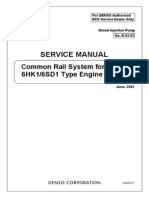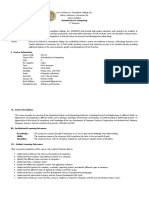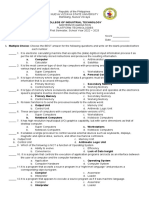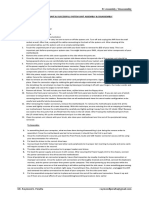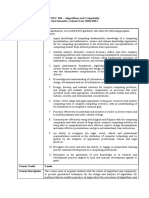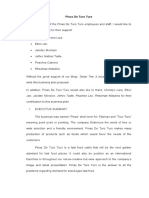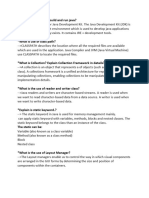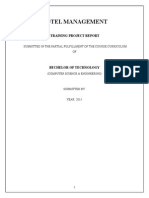Computer Programming Module 1
Uploaded by
Jess VituallaComputer Programming Module 1
Uploaded by
Jess VituallaIT1708
Types of Programming
Computer program – It is a sequence of statements intended to accomplish a certain task. It is a set of instructions for a
computer to follow.
Programming – It is a process of planning and creating a program
Low-level Languages – These are the languages that deal with a computer’s hardware components. There are two (2)
common low-level languages: machine language and assembly language.
• Machine Language – It is the language that the computer can directly understand. It is the most basic set of
instructions that the computer can execute. Machine language programs are written in binary codes (0, 1).
• Assembly Language – It is a symbolic form of machine language that is easier for people to read, such as ADD AX DX.
This makes use of instructions in mnemonic form.
o Assembler – a program that translates assembly language instructions into machine language.
High-level Languages – These are the programming languages that use natural languages, such as the English language. A
high-level language has its own syntax.
• Syntax – rules of the language, for example, print or write is used to produce an output.
• Commands – these are program statements that carry out tasks that the program has to perform, for example, print
this word or add these two (2) numbers.
• Compiler – it is a program that translates a program written in a high-level language into a low-level language before
executing the program statements.
• Interpreter – this acts as a compiler, but it translates one (1) program statement at a time, this executes the
statement as soon as it is translated.
• Syntax errors – these are errors that might be encountered during the process of translation. An example is a
misspelled command.
• Logical errors – errors that occur when the syntax of the program is correct, but the expected output is not.
• Debugging – the process of locating and correcting the errors of a program.
Programming Cycle
Algorithm – It is a problem-solving technique used in solving programming problems. It is a step-by-step problem-solving
process in which a solution is arrived at in a finite amount of time.
The problem-solving process in the programming environment involves the following steps:
1. Problem Analysis: Analyze the problem and outline the problem and its solution requirements.
2. Algorithm Design: Design an algorithm to solve the problem.
3. Coding: Implement the algorithm in a programming language.
4. Execution: Verify that the algorithm works.
Figure 1 summarizes the programming process.
Figure 1. Problem analysis-coding-execution cycle (Malik, 2012)
To develop a program that solves a problem, start first by analyzing the problem, then outlining the problem and the options
for a solution. Then design the algorithm, write the program instructions, and enter the program into a computer system.
01 Handout 1 *Property of STI
Page 1 of 3
IT1708
Algorithm
An algorithm must be expressed completely in a natural language that anyone can follow, such as directions that can be
written in the English language. The computer programmer lists down all the steps required to resolve a problem before
writing the actual code.
Example:
Design an algorithm that finds and displays the volume of a rectangle. It is required to know the rectangle’s length, width,
and height, and the formula to know the rectangle’s volume. The formula is volume = length × width × height.
The algorithm to find and display the volume of the rectangle is:
1. Get the length of the rectangle.
2. Get the width of the rectangle.
3. Get the height of the rectangle.
4. Find the volume using the formula: volume = length × width × height.
5. Display the computed volume.
There are two (2) commonly used tools in representing an algorithm:
• Pseudocode
• Flowchart
Pseudocode
Pseudocode – is a method of describing computer algorithms using a combination of natural language and programming
language. It is a technique to show the programming steps.
The following are some rules that are frequently followed when writing pseudocode:
• Symbols are used for the following common operations:
o Arithmetic operations (+, -, *, /)
o Assignment (=)
o Comparison (=, ≠, <, >, ≤, ≥)
o Logical (and, or)
• Certain keywords can be used as a command, such as PRINT, WRITE, READ, SET, GO TO, etc.
• Indentation is used to indicate branches and loops of instructions.
Example:
Using the example problem in the algorithm.
The pseudocode to find and display the volume of the rectangle is:
READ length
READ width
READ height
SET volume to 0
COMPUTE volume as length * width * height
PRINT volume
Flowchart
Flowchart – is a visual representation of an algorithm. It contains shapes describing how an algorithm or program operates.
Each command is placed in an appropriate shape, and arrows are used to direct program flow.
Flowchart shapes represent various operations. These shapes are connected by directed lines to indicate the flow of data or
control from one (1) point to another. Table 1 shows the often-used shapes in a flowchart.
Table 1: Flowchart shapes and functions
Flowchart Shape Function
Flow lines: Used to indicate the direction of the process flow by
connecting other shapes. Arrows should not cross each other.
Terminal block: Used to represent the beginning or end of a program.
01 Handout 1 *Property of STI
Page 2 of 3
IT1708
Flowchart Shape Function
Process: Used to represent a process step or activity, such as
computation, initialization, etc.
Data: This represents the data used as inputs or outputs, such as user
input and display text.
Decision block: This indicates a decision operation in the process,
where there are two (2) alternatives: true and false.
Connector: Used as a connector to combine flow lines by indicating an
identifier, such as letters. This is used for complex algorithms.
Predefined Process: Indicates the use of an algorithm specified outside
the program, such as methods or functions.
Example:
Using the example problem in the algorithm
The flowchart to find and display the volume of the rectangle is:
Programming Methodologies
Programming methodology – is the approach to analyzing such complex problems by planning software development and
controlling the development process. There are two (2) popular approaches to writing computer programs:
Procedural Programming – in this approach, the problem is broken down into functions that perform one (1) task each. This
approach is suitable only for small programs that have a low level of complexity.
Object-Oriented Programming – in this approach, programs are organized around objects rather than actions, and data
rather than logic. The solution resolves around entities or objects that are part of the problem. It deals with how to store
data related to the entities, how the entities behave, and how they interact with each other to give the desired result.
Figure 2. Representation of Procedural and Object-Oriented programming
REFERENCES:
Baesens, B., Backiel, A., & Broucke, S. (2015). Beginning java programming: The object-oriented approach. Indiana: John Wiley & Sons,
Inc.
Farrell, J. (2014). Java programming, 7th edition. Boston: Course Technology, Cengage Learning.
Savitch, W. (2014). Java: An introduction to problem solving and programming, 7th edition. California: Pearson Education, Inc.
01 Handout 1 *Property of STI
Page 3 of 3
You might also like
- R. Gimarino BTLED-ICT 329 Website Development Author Wares SyllabusNo ratings yetR. Gimarino BTLED-ICT 329 Website Development Author Wares Syllabus26 pages
- SJLSHS - Computer Programming - Oracle DatabaseNo ratings yetSJLSHS - Computer Programming - Oracle Database48 pages
- Lesson Exemplar Programming 12 Quarter 4 Week 1 and 2100% (2)Lesson Exemplar Programming 12 Quarter 4 Week 1 and 23 pages
- IT 111-Introduction To Computing I. MODULE III - Key Components of A Computer System, Operating SystemsNo ratings yetIT 111-Introduction To Computing I. MODULE III - Key Components of A Computer System, Operating Systems25 pages
- JEDI Slides Intro1 Chapter 00 Introduction100% (1)JEDI Slides Intro1 Chapter 00 Introduction11 pages
- Computer Programming (Quarter 2-Module 2)No ratings yetComputer Programming (Quarter 2-Module 2)9 pages
- Inte 30013 Bsit Obe Format Programming 3 Structured ProgrammingNo ratings yetInte 30013 Bsit Obe Format Programming 3 Structured Programming6 pages
- Computer Programming: Quarter 1 Week 1 Module 1No ratings yetComputer Programming: Quarter 1 Week 1 Module 17 pages
- Install and Uninstall Software On Windows PC: LessonNo ratings yetInstall and Uninstall Software On Windows PC: Lesson5 pages
- Career Opportunities in Computer Hardware Servicing50% (2)Career Opportunities in Computer Hardware Servicing2 pages
- Lesson 1 Plan and Prepare For Installation100% (2)Lesson 1 Plan and Prepare For Installation117 pages
- G11-TVL-ICT Programming (.Net Technology) Capslet Quarter 3-Week 1No ratings yetG11-TVL-ICT Programming (.Net Technology) Capslet Quarter 3-Week 110 pages
- Parts of Back Panel Ports: Computer Monitor Audio USBNo ratings yetParts of Back Panel Ports: Computer Monitor Audio USB2 pages
- Assemble Computer Hardware I. Multiple Choice100% (1)Assemble Computer Hardware I. Multiple Choice6 pages
- Rich Content in The Online Environment and The User ExperienceNo ratings yetRich Content in The Online Environment and The User Experience5 pages
- Department of Education: Table of Specification in Computer Programming 12No ratings yetDepartment of Education: Table of Specification in Computer Programming 121 page
- Computer Programming 1: Ma. Rhodora R. Gallo InstructorNo ratings yetComputer Programming 1: Ma. Rhodora R. Gallo Instructor96 pages
- Discuss About Introduction of Animation: Grade 12 Information Communication Technology Animation NC IiNo ratings yetDiscuss About Introduction of Animation: Grade 12 Information Communication Technology Animation NC Ii7 pages
- CSPC 104 - Algorithms and Complexity 2nd Semester, School Year 2020-2021100% (1)CSPC 104 - Algorithms and Complexity 2nd Semester, School Year 2020-20213 pages
- Learning Activity Sheet Special Program in Ict 9 Computer Systems Servicing 9No ratings yetLearning Activity Sheet Special Program in Ict 9 Computer Systems Servicing 911 pages
- Third Quarter Exam Computer Programming (Java)No ratings yetThird Quarter Exam Computer Programming (Java)5 pages
- 11222021110314TVL-ICT - PROGRAMMING - GRADE-11 - QTR-2 Module 1No ratings yet11222021110314TVL-ICT - PROGRAMMING - GRADE-11 - QTR-2 Module 120 pages
- Information and Communications Technology 8 Quarter 1 - Module 1: Lesson 1 Title:History of Programming LanguageNo ratings yetInformation and Communications Technology 8 Quarter 1 - Module 1: Lesson 1 Title:History of Programming Language18 pages
- Grade 12 Animation Course - Outline For StudentsNo ratings yetGrade 12 Animation Course - Outline For Students2 pages
- Information and Communications Technology: Computer System ServicingNo ratings yetInformation and Communications Technology: Computer System Servicing14 pages
- Types of Programming: This Word or Add These Two (2) Numbers100% (1)Types of Programming: This Word or Add These Two (2) Numbers3 pages
- Directions: Provide What Is Being Asked. Write Your Answers On The Space Provided Below. (2 Items X 25 Points)No ratings yetDirections: Provide What Is Being Asked. Write Your Answers On The Space Provided Below. (2 Items X 25 Points)2 pages
- Shangha I Diesel Engine G128ZL Caf Dong Feng China G 10600240 5No ratings yetShangha I Diesel Engine G128ZL Caf Dong Feng China G 10600240 52 pages
- 202241925-TricentisTosca - External TrainingNo ratings yet202241925-TricentisTosca - External Training2 pages
- Development of A Framework of Research Topics in System EngineeringNo ratings yetDevelopment of A Framework of Research Topics in System Engineering13 pages
- Module 1: Introduction Automated Systems Course ContentNo ratings yetModule 1: Introduction Automated Systems Course Content7 pages
- The Islamia University of Bahawalpur: Department of Software EngineeringNo ratings yetThe Islamia University of Bahawalpur: Department of Software Engineering14 pages
- Konteks Manajemen Proyek Dan Teknologi InformasiNo ratings yetKonteks Manajemen Proyek Dan Teknologi Informasi42 pages
- Hotel Management: Training Project ReportNo ratings yetHotel Management: Training Project Report43 pages
- LOWW - Arrival - Transition 29 - 26012023No ratings yetLOWW - Arrival - Transition 29 - 260120235 pages



